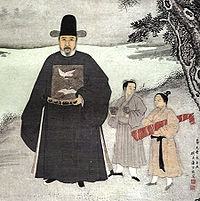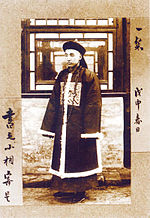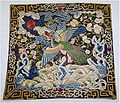- Mandarin square
-
A Mandarin square (traditional Chinese: 補子; simplified Chinese: 补子; pinyin: bŭzi; Wade-Giles: putzŭ), also known as a rank badge, was a large embroidered badge sewn onto the surcoat of an official in Imperial China. It was embroidered with detailed, colourful animal or bird insignia indicating the rank of the official wearing it.
Contents
Ming Dynasty
 A Ming Dynasty portrait of the Chinese official Jiang Shunfu (1453–1504). The Mandarin Square indicates that he was a civil official of the first rank.
A Ming Dynasty portrait of the Chinese official Jiang Shunfu (1453–1504). The Mandarin Square indicates that he was a civil official of the first rank.
Mandarin squares were first authorized for wear in 1391 by the Ming Dynasty. The use of squares depicting birds for civil officials and animals for military officials was an outgrowth of the use of similar squares, apparently for decorative use, in the Yuan Dynasty.[1] The original court dress regulations of the Ming Dynasty were published in 1368, but did not refer to badges as rank insignia.[2] These badges continued to be used through the remainder of the Ming and the subsequent Qing Dynasty until the imperial system fell in 1912.
Ming nobles and officials wore their rank badges on full-cut red robes with the design stretching from side to side, completely covering the chest and back. This caused the badges to be slightly trapezoidal with the tops narrower than the bottom.[3] The Ming statutes never refer to the number of birds or animals that should appear on the badges. In the beginning, two or three were used. In a typical example of paired birds, they were shown in flight on a background of bright cloud streamers on a gold background. Others showed one bird on the ground with the second in flight. The addition of flowers produced an idealized naturalism.[4][5]
Qing Dynasty
There was a sharp difference between the Ming and Qing styles of badges: the Qing badges were smaller with a decorative border.[6] And, while the specific birds and animals did not change much throughout their use, the design of the squares underwent an almost continual evolution.[7] According to rank, Qing-Dynasty nobles had their respective official clothes. Princes, including Qin Wang and Jun Wang, usually wore black robes as opposed to the blue robes in court, and had four circular designs, one on each shoulder, front, and back, as opposed to the usual front-and-back design. Specifically, Princes of the Blood used four front-facing dragons, Qin Wang had two front-facing and two side-facing dragons, and Jun Wang had four side-facing ones; all had five claws on each foot. Beile and Beizi had a circular design on their official clothing, the former having two front-facing dragons, the latter two side-facing ones; these dragon had only four claws on each foot, and are referred to as "drakes" or "great serpents" (巨蟒 jù-mǎng). National Duke, General, Efu, "Commoner" Duke, Marquis and Count had two front-facing, four-clawed dragons on square designs, whereas Viscount and Baron had cranes and golden pheasants, as for Mandarins of the First and Second Class.
-
5th Military Rank (Bear). Kesi. Circa 1860.
Tables
The specific birds and animals used to represent rank varied only slightly from the inception of mandarin squares until the end of the Qing Dynasty. These tables show this evolution.
Military
Rank Ming (1391–1526) Ming and Qing (1527–1662) Late Qing (1662–1911) 1 Lion Lion Qilin (after 1662) 2 Lion Lion Lion 3 Tiger or Leopard Tiger Leopard (after 1664) 4 Tiger or Leopard Leopard Tiger (after 1664) 5 Bear Bear Bear 6 Panther Panther Panther 7 Panther Panther Rhinoceros (after 1759)[8] 8 Rhinoceros Rhinoceros Rhinoceros 9 Rhinoceros Sea Horse[9] Sea Horse[10] Civilian
Rank Ming (1391–1526) Ming and Qing (1527–1662) Late Qing (1662–1911) 1 Crane or Golden Pheasant Crane Crane 2 Crane or Golden Pheasant Golden Pheasant Golden Pheasant 3 Peacock or Wild Goose Peacock Peacock 4 Peacock or Wild Goose Wild Goose Wild Goose 5 Silver Pheasant Silver Pheasant Silver Pheasant 6 Egret or Mandarin Duck Egret Egret 7 Egret or Mandarin Duck Mandarin Duck Mandarin Duck 8 Oriole, Quail or Paradise Flycatcher Oriole Quail 9 Oriole, Quail or Paradise Flycatcher Quail Paradise Flycatcher[11] See also
- Rank badge, for the analogous design in Korea
- Hanfu, Gwanbok
- Chinese hat knob
- Byzantine dress for the similar "tablion"
- Nine-rank system, for an earlier system for ranking officials in China
Notes
- ^ Cammann, Schuyler: Birds and Animals as Ming and Ch’ing Badges of Rank", Arts of Asia (May–June 1991), page 89.
- ^ Cammann, Schuyler: "Development of the Mandarin Square", Harvard Journal of Asiatic Studies Vol VIII, no 2 (1944), pages 75–6.
- ^ Cammann, Schuyler: "Chinese Mandarin Squares, Brief Catalogue of the Letcher Collection", University Museum Bulletin Vol 17, No 3 (June 1953), pages 8–9.
- ^ Cammann, Schuyler: "Chinese Mandarin Squares, Brief Catalogue of the Letcher Collection", University Museum Bulletin Vol 17, No 3 (June 1953), page 9.
- ^ Cammann, Schuyler: "Development of the Mandarin Square", Harvard Journal of Asiatic Studies Vol VIII, no 2 (1944), page 95.
- ^ Cammann, Schuyler, "Birds and Animals as Ming and Ch’ing Badges of Rank", Arts of Asia (May–June 1991), page 90.
- ^ Jackson, Beverley & Hugus, David, Ladder to the Clouds, Berkeley: Ten Speed Press, 1999, Chapter 15, pages 215–289.
- ^ Note that the Rhinoceros is depicted as a buffalo, rather than as a rhinoceros.
- ^ Note that the Sea Horse is depicted as a horse living under water, rather than as a seahorse.
- ^ Jackson, Beverley & Hugus, David, Ladder to the Clouds, Berkeley: Ten Speed Press, 1999, Table 4, page 133;
- ^ Jackson, Beverley & Hugus, David, Ladder to the Clouds, Berkeley: Ten Speed Press, 1999, Table 3, page 133.
Further reading
- "Rank insignia for military officers of the imperial court", in: Welch, Patricia Bjaaland (2008), Chinese Art, Tuttle, pp. 110—111, ISBN 080483864X, http://books.google.com/books?id=5sgO9BuZQSEC&pg=PA110
Types of Han Chinese clothing Han clothing Headwear Other Phoenix crown · Mandarin square List of Han Chinese clothingCategories:
List of Han Chinese clothingCategories:- Chinese clothing
- History of Imperial China
- Insignia
- Orders, decorations, and medals of the Empire of China
Wikimedia Foundation. 2010.




